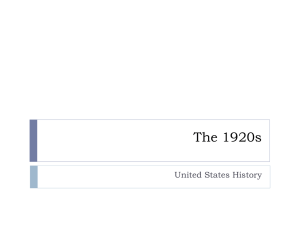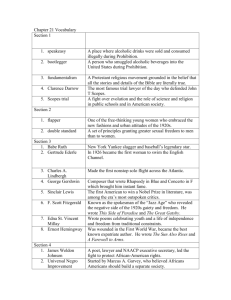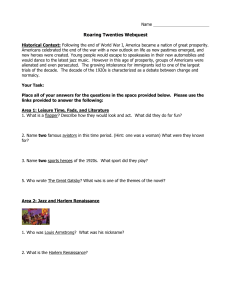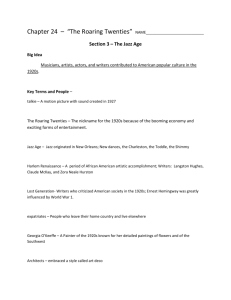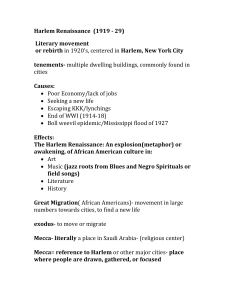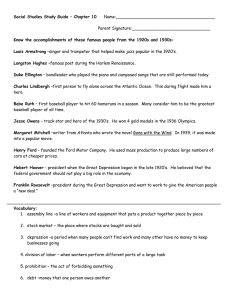Ch 31 - American Life in the Roaring 20s
advertisement
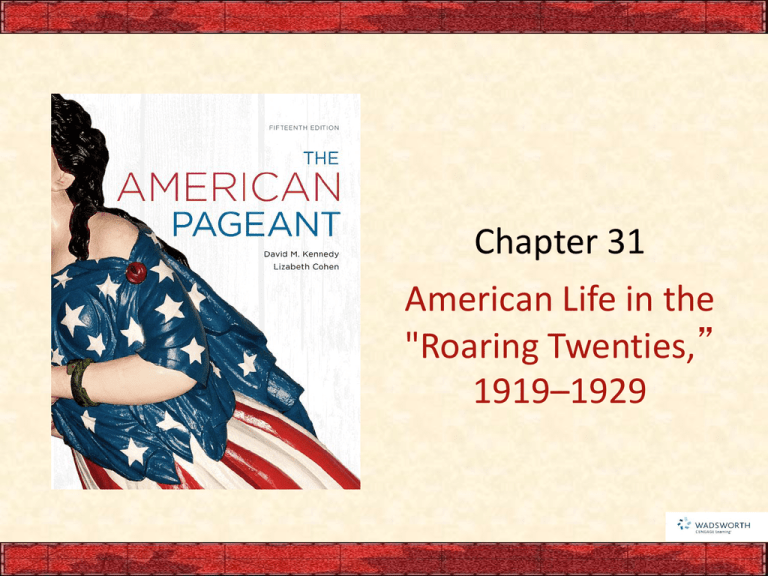
Chapter 31 American Life in the "Roaring Twenties,” 1919–1929 I. Seeing Red • Bolshevik Revolution(1919):Russian Communism – Effects on the United States: • A small Communist Party emerged • The big red scare of 1919-1920 – Blamed for some labor strikes – Crusades against left-wingers / Eastern Europeans – Attorney General A. Mitchell Palmer raids – Other events during the red scare • • • • • Deportation of radicals to Russia / Soviet Union Wall Street bombing (38 killed & ~100 wounded) criminal syndicalism laws passed by states Elected Socialist New York legislators denied their seats Sacco and Vanzetti trial p701 II. Hooded Hoodlums of the KKK • A new Ku Klux Klan: – Antiforeign “nativist” movement – Extremist, ultraconservative uprising against: • Diversity and modernity of American culture. – Most popular in Midwest &Bible Belt South • Associated with Protestant Fundamentalism • Things of the KKK: – “Knights of the Invisible Empire” – “konclaves,” parades, cross burning • Collapsed rather suddenly in the 1920s. – Financial & criminal scandals – Open intolerance & prejudice fell out of favor p702 III. Stemming the Foreign Flood • Isolationist America had little use for immigrants – “New Immigrants” from southern / eastern Europe – Congress passed the “Emergency Quota Act” (1921) • Newcomers from Europe were restricted to a quota • Immigration Act of 1924 – The national origins base shifted from 1910 to 1890 – Purpose to keep existing racial composition. – Japanese / Chinese immigrants not allowed – Departure in American policy – Encouraged ethnic enclaves Immigration limit later cut to 2%. “National origins” quota based on 1890 census (not 1910) p703 Figure 31-1 p704 IV. The Prohibition “Experiment” • Part of the progressive reform movement • Eighteenth Amendment (1919) • Implemented by the Volstead Act – Popular in the South, unpopular in East & in cities – Goal to end the cause of many social problems • Peculiar conditions hampered the enforcement – Tradition by a majority, many loopholes – Federal agencies were unstaffed, underfunded • “Noble experiment” was not entirely a failure – Bank savings increased – Absenteeism in industry decreased – Less alcohol after prohibition ended p705 p706 p707 V. The Golden Age of Gangsterism • Prohibition spawned shocking crimes • Profits of illegal alcohol led to bribery of police • Violent wars in big cities between rival gangs – Chicago- most spectacular example of lawlessness • Al Capone Public Enemy Number One” – Gangsters and other profitable and illicit activities • Prostitution, gambling, narcotics, protection, kidnapping • Racketeers invaded local labor unions • Organized crime became big businesses • 1930 $12 to $18 billion p708 VI. Monkey Business in Tennessee • Required educational in the 1920s – High school graduation doubled • Change in educational theory: – John Dewey (progressive, permissive) “learn by doing” • “Education for life”, the workbench and blackboard • Science made advancements: – Massive health, nutrition, knowledge programs – “Fundamentalists” unhappy with “evolution” • “Monkey Trial” – HS teacher John Scopes in Dayton, Tenn. (1925) – Trial between Bryan and Darrow – Results Bryan won but looked foolish p709 VII. The Mass-Consumption Economy • Economic Prosperity of the “roaring” twenties • The automobile – Created a shift in the character of the economy • Advertising – Increase knowledge & demand for new products • Sports – Became big business in the ‘consumption era’ – “Babe” Ruth, Jack Dempsey gained fame/fortune • Buying on credit – “Possess today and pay tomorrow” the message • Refrigerators, vacuum cleaners, cars and radios—now – Prosperity based on ‘credit’ was unstable p710 VIII. Putting America on Rubber Tires • Automobile – New industrial systems • Assembly-line methods & Mass-production techniques – Americans adapted the gasoline engine • Ford and Olds developed the infant automotive industry • Detroit became the motorcar capital of America • Scientific Management • Stopwatch efficiency (Frederick W. Taylor) – Henry Ford • Model T (“Tin Lizzie”) -cheap, rugged, and reliable • Devoted himself to standardization • The moving assembly line—Fordism p711 Figure 31-2 p712 Figure 31-3 p712 IX. The Advent of the Gasoline Age • Tremendous Impact of the self-propelled carriage – Dependent on steel, rubber, glass, highway construction • American standard rose to an enviable level. – The petroleum business expanded • Oil derricks shot up in California, Texas, Oklahoma – Delivery of perishable foodstuffs accelerated – Countless new roads • Motorcars were agents of social change: – – – – – At first a luxury, they rapidly became a necessity More freedom & equality for women and teenagers Isolation among the regions began to break down Consolidation of schools, churches, rural areas Automobiles fast, convenient, enjoyable, and exciting p713 p713 X. Humans Develop Wings • Orville and Wilbur Wright – “The miracle at Kitty Hawk” on December 17, 1903 • Airplanes (“flying coffins”) – Military, mail, and passenger lines – Charles A. Lindbergh -solo Atlantic flight • The impact of the ‘airship’ was tremendous – Gave the ‘American spirit’ another dimension – Gave birth to a new industry & lifestyle – Increased tempo of civilization • Communication, transportation, destruction – Decreased the ‘size’ of the world p714 XI. The Radio Revolution • Guglielmo Marconi, invented wireless telegraph – Long-range WWI communication • Voice-carrying radio (Nov 1920) – Pittsburgh station KDKA -broadcast election results – At first local, then national commercial networks • Led to later achievements – Transatlantic radio, telephones, television, internet – Advertising “commercials” expanded radio – Help unite the nation culturally • Sports, news, music, comedy, national name brands • Politicians adjusted to and used the new medium p715 XII. Hollywood’s Filmland Fantasies • The Great Train Robbery (1903) First serial • Birth of a Nation (1915) First full-length movie • Hollywood became the world’s movie capital – Used in World War I, anti-German propaganda: – The Jazz Singer (1927)—first successful “talkie” • Movies became more popular – Color films developed, movie “stars” • Effects of the new mass media – Critics, the lowering of community standards – Ethnic communities & diversity eroded • Standardization of tastes & language (fewer local dialects) – Development of “American mainstream” XIII. The Dynamic Decade • Many changes in lifestyles and values: • Americans more rural than urban • More women employed, Equal Rights Amendment • “Flapper” symbolized a more independent lifestyle – Many taboos flew out the window • They danced to jazz, smoked & drank in public • Fundamentalists lost ground to the Modernists • Advertisers exploited sexual allure • New racial pride in northern black communities: • Harlem Renaissance (NYC) – Art, music, writings, perfermances • Marcus Garvey, Black political leader – United Negro Improvement Association (UNIA) p716 p717 p718 p718 p719 p719 XIV. Cultural Liberation: Literature • Modernism - “Lost Generation” – Questioned past traditions, typical conventions – H.L. Mencken – F. Scott Fitzgerald – Ernest Hemingway • Non-radical writers – Carl Sandburg – Sinclair Lewis – William Faulkner • Harlem Renaissance Writers – Claude McKay – Langston Hughes – Zora Neale Hurston XIV. Cultural Liberation: (con’t) Performance • American composers & playwrights contribute • Jerome Kern • Oscar Hammerstein • Eugene O’Neill • Architecture • Frank Lloyd Wright • Harlem Renaissance: – A black cultural renaissance in uptown Harlem • Jazz artists –Louis Armstrong –Eubie Blake p721 p722 p723 XV. Wall Street’s Big Bull Market • Economic conditions of the 1920s – Consumer spending / confidence high – Speculation (land, stock) rampant & banks unstable – Buying stocks “on margin” for quick profit • Washington didn’t curb money-mad speculators – 1921 Congress moved toward economic sanity • Created the Bureau of the Budget – Helped create an annual budget – Secretary of the Treasury Andrew Mellon • • • • Engineered a series of tax reductions from 1921 to 1926 Tax burden shifted from the wealthy to the middle class Reduced the national debt by $10 billion Accused of indirectly encouraging the bull market Calvin Coolidge Presides over the “Jazz Age” Coolidge’s handsoff policies were sweet music to big business. p725 p727

